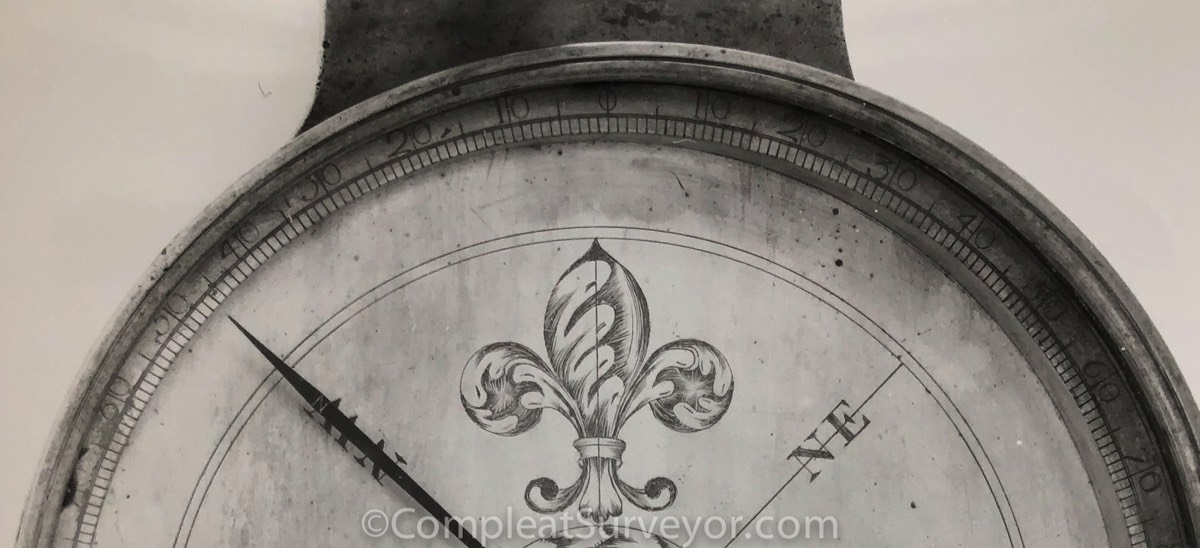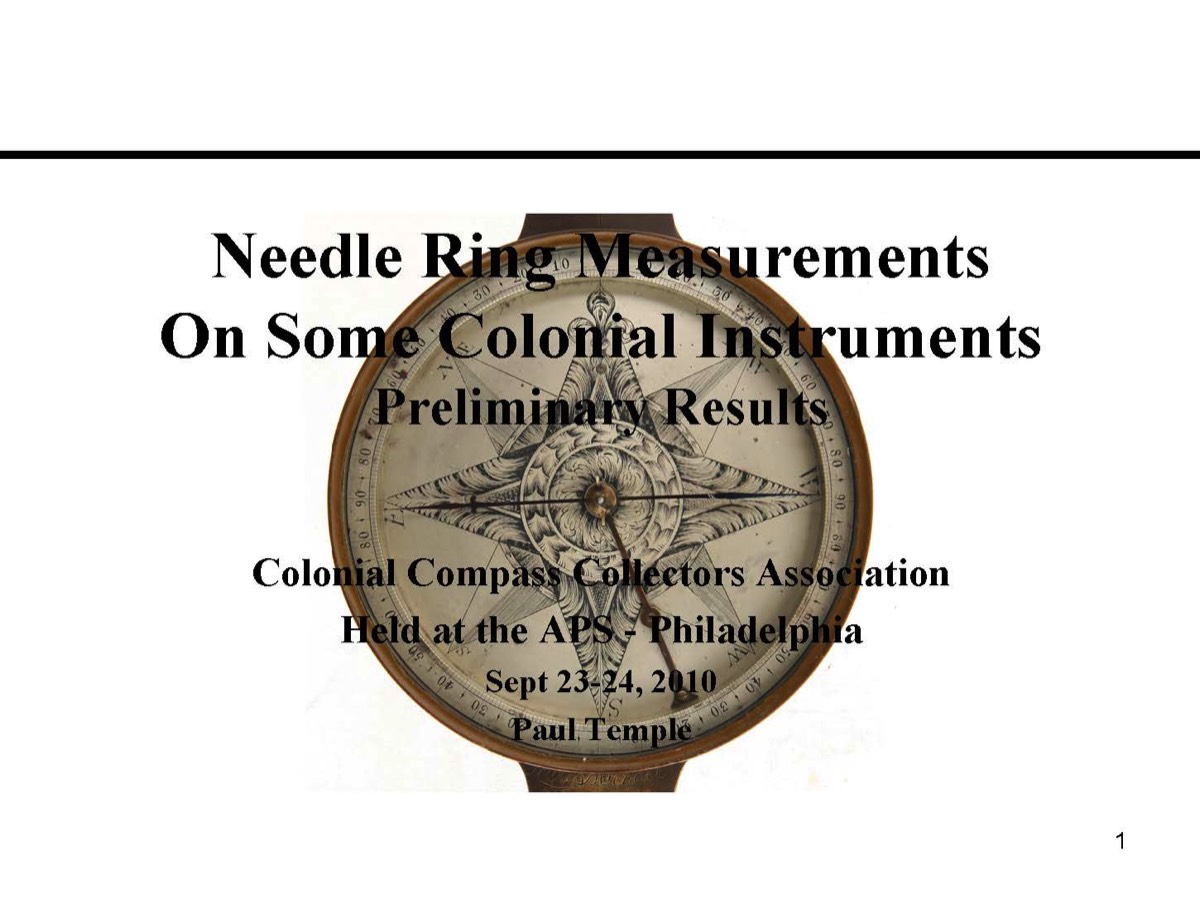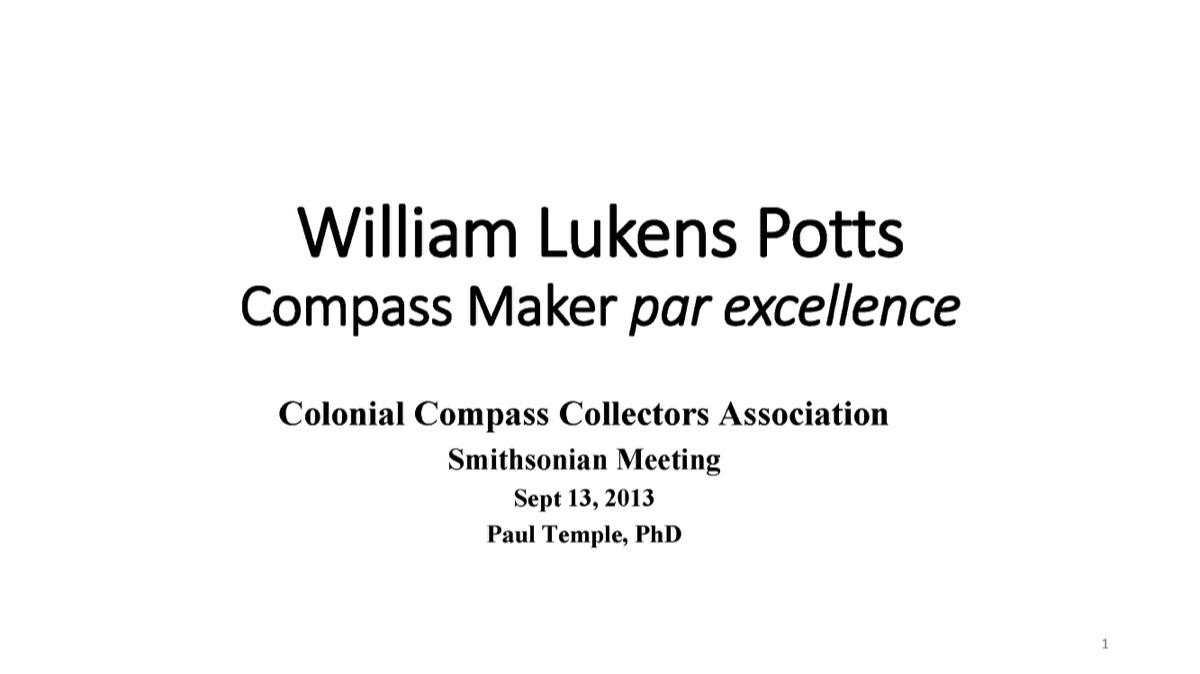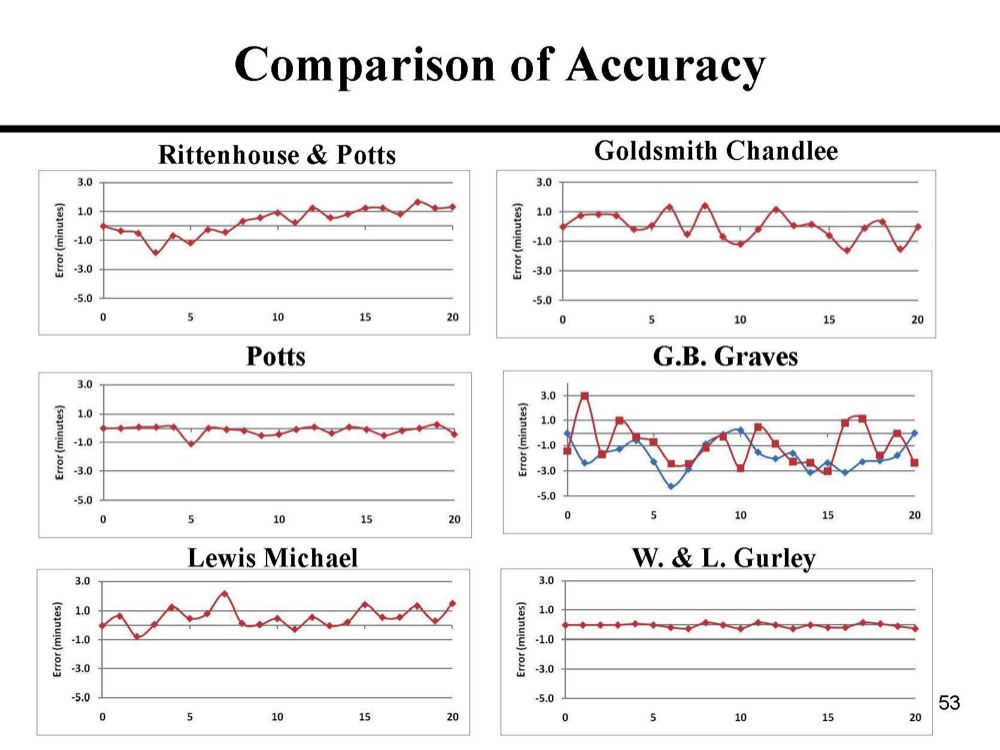
The Accuracy of Colonial and early American Compassess
How Accurate Were Divided Rings of Colonial and Early American Compasses?
As you might suspect, not all compass rings were divided equally. To the naked eye, brass compasses look to be divided much more accurately than wood compasses. The naked eye has a more difficult time judging the accuracy of the divisions on a brass compass, but the accuracy of the divisions differed significantly from maker to maker. Two hobbyists, both physicists, independently tested a number of brass compasses made by different makers to determine just how accurately makers could divide the compass ring. The results were fascinating.
Let's put accuracy in perspective first. If a Compass is off by 15 minutes, the difference in the directions of two lines (one accurate, the other off by 15 Mintues) would be:
At 100 Feet Difference of 5.25 inches
At 1000 Feet Difference of 4.5 feet
At 1 Mile Difference of 23 feet
Another Data Point:
In his 1786 article about how to make a Minute Compass, Robert Patterson says that a surveyor could only read a compass to the nearest 15 to 20 minutes of a degree.
A Colonial or Early American surveyor could do better than a reading a bearing to the nearest 15 to 20, however, by using a Minute Compass. As explained on the Minute Compass webpage, Minute Compasses were designed to enable surveyors to read to the nearest 1 to 5 minutes (depending on the type of Minute Compass).
As explained on the Vernier Compass webpage, a skilled surveyor could also use the vernier scales on a Vernier Compass to read a bearing more accurately.
The ability of a surveyor to accurately estimate the bearing in minutes made a difference in the quality of a survey. The relative angles of a survey were much more likely to be accurate as the surveyor reduced the guesstimate part of the bearing, say from 20 minutes down to 5 minutes.
Keep in mind that magnetic needles rarely agreed on the exact location of the magnetic North Pole - sometimes they disagreed by 30 minutes or more.
Wood Compasses - Printed Cards
Wood compasses all had printed cards for a compass face, so the dividing of the needle ring was part of the printing process. Take a look at the Circa 1760 Greenough (left) and Circa 1770 Warren (right) compass pics below. Note the lack of uniformity in the spacing and thickness of the degree divisions.
I have not seen anything that discusses the accuracy of wooden compasses. The compass on the left was made by a noted maker Thomas Greenough (who also made brass compasses), and the printer was said to be Paul Revere, but the compass card doesn't look nearly as accurate as the engraved rings of the brass compasses I've seen. I wouldn't be surprised of the divisions on this compass card were plus or minus 15 minutes of a degree. Which was probably very adequate accuracy given the plentifulness of land and considering the cost versus benefit of additional accuracy.

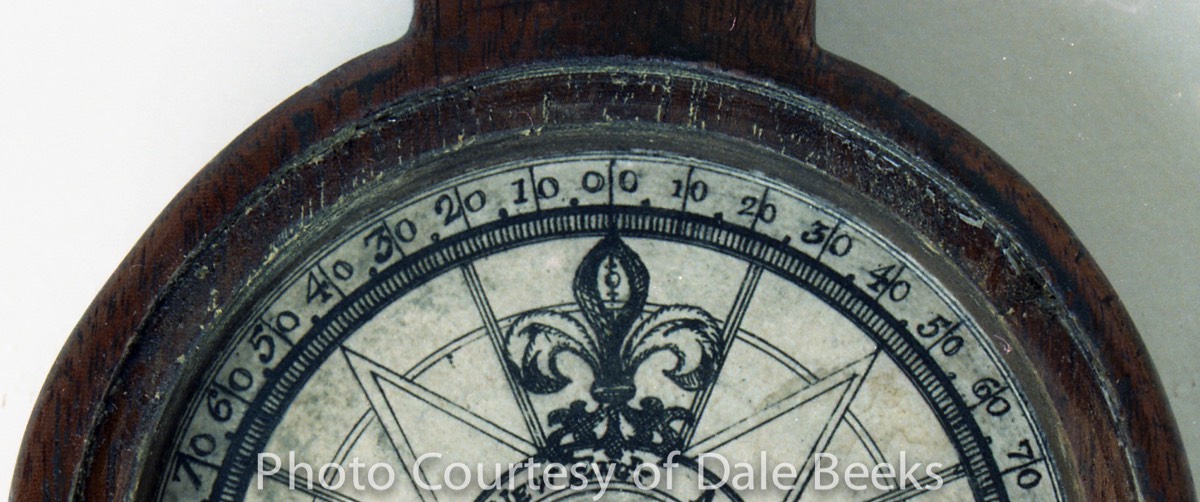
Brass Compasses - Engraved Rings
Brass compass could be engraved much more accurately than wood compasses. A line engraved on brass could be much more finely placed than ink printed on paper via a printing press process. But not all brass companies were divided equally.
The accuracy of the divisions on a needle ring varied by the skill of the makers involved and the tools the maker had to dividing needle rings. Makers divided the needle rings of brass compass in three different ways, with meaningful different results. For those who want to do a deep dive into this area, take a look at Jeff Lock's article in the Fall 2004 edition of The American Surveyor, "Dividing the Needle Ring of a Colonial Compass".
Take a look at the two Compass below. On the left is an unsigned compass pic that I found in Bedini's Smithsonian files (click on the pic to enlarge). While the spacing between the division marks look to be fairly consistent, I do see some possibly different spacings. The picture on the right is a Compass made by Anthony Lamb (probably between 1750 and 1780), with the needle ring divided to 30 minutes. It's hard to to say how accurately Lamb divided his needle rings, but the Lamb compass is obviously divided in a much more precise and crisp way. The Smithsonian holds the Lamb compass as well.
Below is a compass that Benjamin Rittenhouse made for Andrew Ellicott in the 1790s (BR made several compasses for Ellicoot). Note how evenly and perfectly the lines look divided on this compass, especially compared to the Greenough wood compass pictured above. You can see more pics of the Rittenhouse Ellicott Compass at the National Museum of American History (click here).
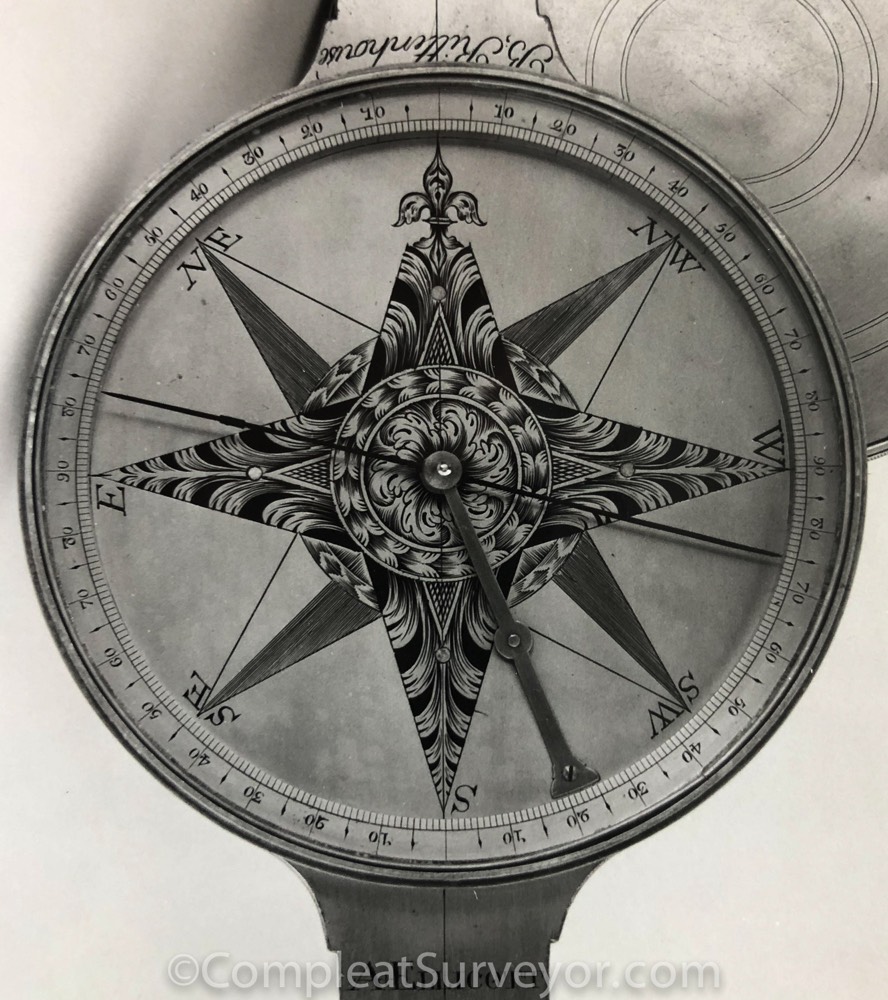
Comparing the Accuracy of Different Compass Makers - Paul Temple
Paul Temple, a physicist and surveying instrument collector, created a way to measure the accuracy of the engraving on early brasses compasses. Paul's approach and analysis are extraordinary, and add a new layer of appreciation as you view these wonderful old compasses.
So….how accurately could a maker divided a compass in 1800 you ask?? Well, William Potts could divide a compass nearly at the same level of accuracy as a Gurley dividing engine made nearly 60 years later!
But Potts was EXTREMELY accurate - much more so than his contemporaries.
Take a look at the chart below. Here you see the accuracy of 6 different well known makers compared. Paul measured and then charted the accuracy of each degree division over 20 degrees for each maker.
Each dot represents a degree division. A dot at 1.0 means that the degree division was plus 1 Minute from where it should be. A dot at -3 means that the degree division was minus 3 minutes from where it should be. A perfectly engraved needle ring would have all the dots on the ZERO line. As you can see below, the Gurley dividing engine was very close to perfect.
If you compare the 5 Early American Compass makers against each other, Potts divided his compasses much more accurately and consistently that the other four makers. Not surprising, Graves, who apprenticed under Goldsmith Chandlee until Chandlee passed away, was the most inaccurate and inconsistent. He made far fewer compasses than the others, so his skill level never approached the skill levels of the others.
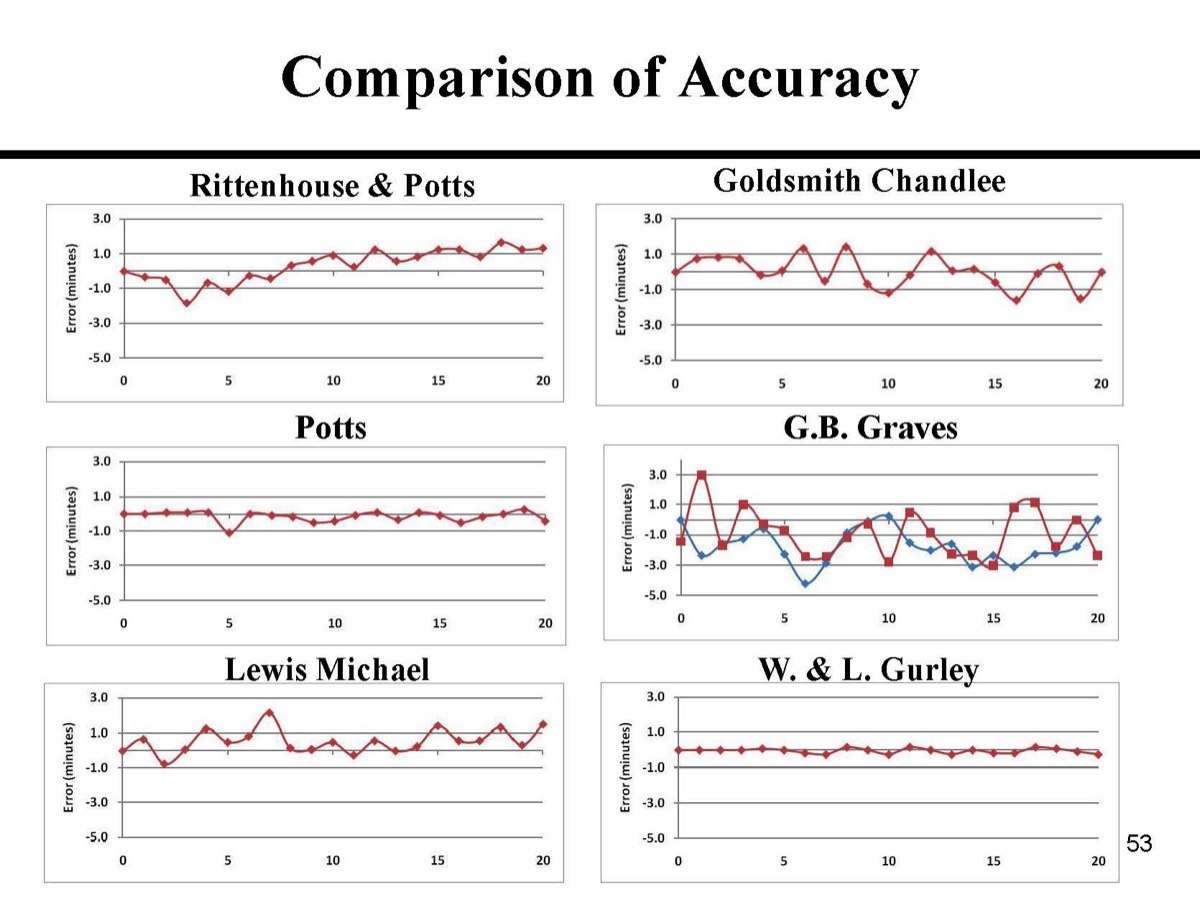
Paul Temple prepared two presentations for Jeff Lock's Colonial Compass Collectors Association discussing the accuracy of the early compass makers. Paul's two presentations (offered below) are an amazing reference work for those eager to take a deeper dive into the art of colonial compass making!
This was Paul Temple's first presentation on the Accuracy of the Needle Ring. Eighty page slide deck, chock full of fascinating information. The deck goes thru Paul's methodology, discussed the different ways to divide a needle ring, analyzes the accuracy of various different makers, etc.
Paul Temple's second major presentation dealing with compass accuracy, but this one is focused primarily on William Potts (as the title page to the 124 page slide deck indicates). Temple found Potts to be extraordinarily and bafflingly accurate - about as accurate as a Gurley dividing engine used 60 years alter.
Comparing the Accuracy of Different Compass Makers - Robert Miller
Another Hobbyists and Physicist, Robert Miller (the author of the definite work on Solar Compasses) also tested and analyzed how accurately different makers could divide the needle ring. His results appear below, which are presented in a statistical way - with the number of standard deviations listed as the top line.
I read Miller's table this way:
For the first compass listed (W J Young - 1825), based on Bob's observations, you would expect roughly 68% of the divisions on the divided circle would have a maximum error of plus or minus 1.75 minutes of arc. Likewise, you would expect roughly 95% of the divisions on the divided circle would have a maximum error of plus or minus 2.02 minutes of arc. Finally, you would expect the entire divided circle to have a maximum error of plus or minus 2.74 minutes of arc. Miller's analysis depends of course on the errors following a normal statistical curve.
Miller's approach:
Accuracy of Compass Divisions
In order to determine the accuracy of the accuracy of the graduation of surveyors compasses made in the late 18th and early 19th century the errors of the divisions of some 20 compass needle rings, two transit plates and a solar compass plate were determined.
All of the measurements were made on a E. Leitz Wetzlar tool makers microscope with rotary table reading optically to one minute of arc and by estimation to 30 seconds of arc. The needle ring in the case of a plain compass or needle ring and upper plate for a vernier compass was mounted on the upper plate and centered first by eye and then by focusing the telescope on one of the guide circles or the edge of the divided circle and then shifting the ring until the crosshairs remain centered on the guide circle through a full rotation of the table.
In such a case 31.74% of the points will have an error of more that one standard devotion, 4.56% more than two standard deviations and only 0.04% more than three standard deviations.
The results are given in the column marked one theta in table 1 It will be noted that the largest value for the standard deviation is only 2.88 minutes of arc for the Ewin & Heartte compass.
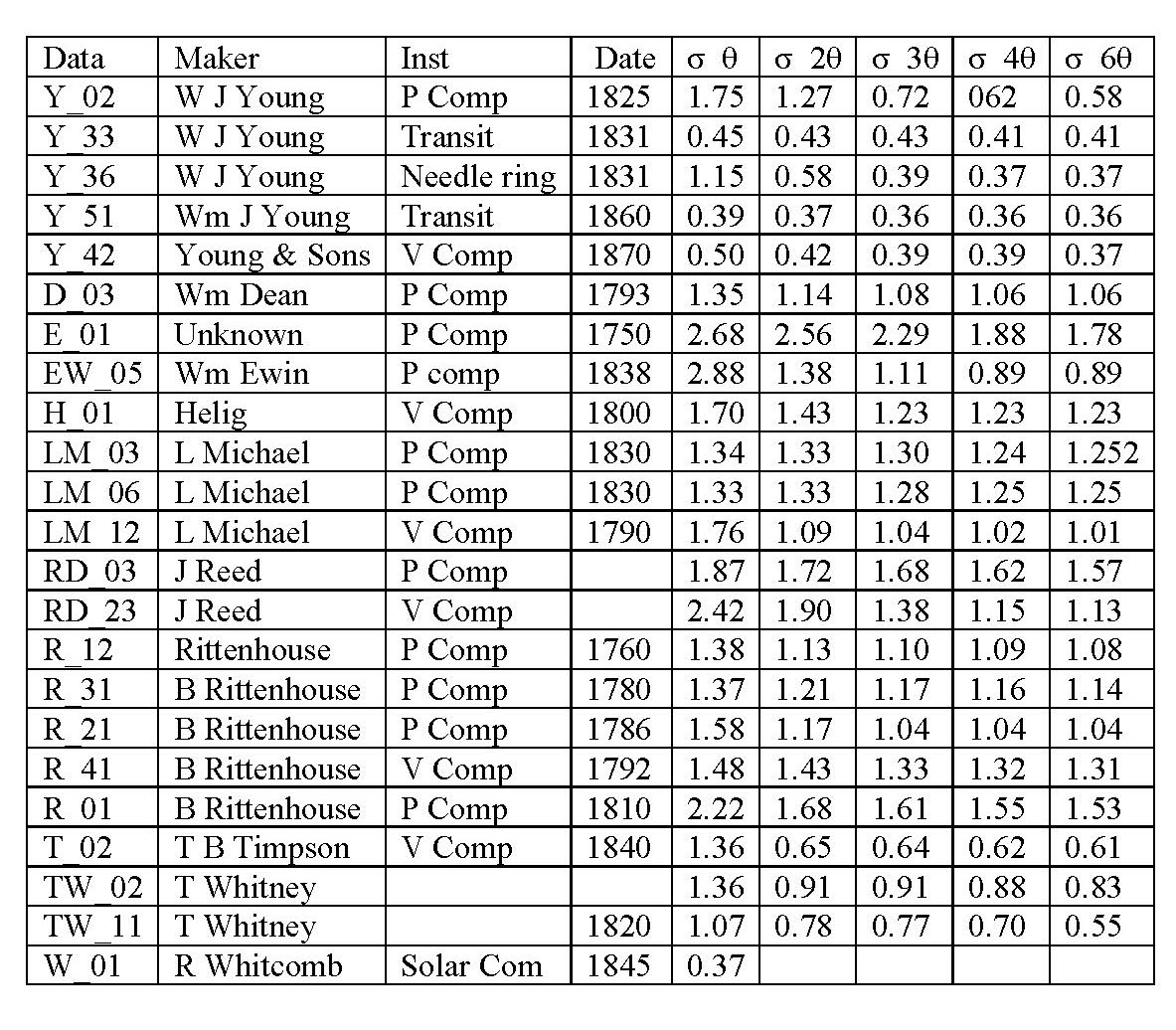
Concluding Thoughts
While some instrument makers were more accurate than others, Colonial and Early American brass compass makers could divide a needle ring with a surprising (to me) amount of accuracy. Looking at the above data points, the divided rings of brass compasses were more than accurate enough given that surveyors could guesstimate to the nearest 15 to 20 minutes of a degree during their surveys. Having said that, I'm amazed at how far ahead the Rittenhouses (and their apprentices/helpers) were in terms of accuracy compared to their competition. Compasses made by the Rittenhouses, Lewis Michael, William Potts, and John Heilig really are quite special.
The accuracy of wood compasses interests me. Wood compasses were obviously adequate at the time and in the geographies they were used. But I would like to see just how my Greenough compass would stack up against a brass compass in terms of accuracy. More to come on this point, hopefully.
I looked at hundreds of online pre-1840 surveys recently - in practice most surveyors apparently just listed the bearing to the nearest degree (e.g., N 18 E). Say 95% of the time.
Thus practically speaking, while accurate divisions were sought for the manufacturing of instruments, the practical application was much different. In Gibson's description of the "Pennsylvania Method" of balancing the latitudes and departures of the field observed bearings and distances, for example, Gibson states that an acceptable tolerance per station, before observation was required, was two (2) tenths of a perch (3.30 feet). Flint and other American authors suggested 5 links (3.30 feet). Consequently the accuracy of instrumentation of the day was well within the desired positional tolerances of the day.
© 2020 Russ Uzes/Contact Me
